Digital Branding Strategies
7 Essential Elements of Visual Branding You Need to Know
Overview
The article emphasizes the crucial elements of visual branding that businesses must grasp to forge a robust and recognizable identity. It delineates seven fundamental components—logo, color palette, typography, imagery, graphic elements, consistency, and emerging trends—that together amplify brand recognition and cultivate consumer loyalty. These elements must operate in unison to nurture emotional connections and trust with customers, underscoring their collective significance in the branding landscape.
Introduction
In a world where first impressions are predominantly visual, the significance of effective visual branding is paramount. This multifaceted concept encompasses:
- logos
- color palettes
- typography
- imagery
All of which are instrumental in shaping consumer perceptions and fostering emotional connections. As businesses navigate an increasingly competitive landscape, a meticulously crafted visual identity emerges as an essential asset, crucial not only for attracting customers but also for cultivating trust and loyalty. By aligning visual elements with the values and expectations of their target audience, brands can forge memorable experiences that resonate deeply, ultimately driving engagement and success in the marketplace. As we explore the core components and emerging trends of visual branding, the critical importance of consistency and innovation will become evident, illustrating how these strategies can significantly elevate a brand’s presence and impact.
Understanding Visual Branding: A Key to Business Success
Graphic identity encompasses all design elements that symbolize a brand, including logos, colors, typography, and imagery. This aspect of brand identity is crucial in shaping public perception and significantly influences consumers’ emotional connections with a brand. In an increasingly competitive market, a well-defined branding strategy is indispensable for businesses striving for success.
A robust identity not only promotes customer recognition but also cultivates trust and loyalty, thereby attracting new clientele. Research indicates that posts featuring images generate 650% more engagement than those with text alone, underscoring the importance of graphic content in capturing consumer attention. Moreover, there exists a substantial opportunity for improvement in consistency, as only 30% of businesses adhere to their guidelines regularly, while 15% lack any guidelines altogether.
This underscores the imperative for companies to maintain consistency in their visual branding to bolster recognition and trust.
Numerous case studies illustrate effective visual branding strategies. For example, research conducted in 2024 reveals that sustainability, inclusion, and diversity increasingly sway purchasing decisions, particularly among Gen Z consumers. The findings indicate that 62% of Gen Z shoppers prefer companies that prioritize sustainability, while 71% of UK buyers trust organizations that align with their values, resulting in enhanced purchasing behavior.
This highlights the necessity for companies to align their aesthetic identity with customer expectations and values, reinforcing the argument that effective imagery can enhance customer loyalty and purchasing decisions.
Furthermore, the significance of aesthetic representation extends to employer branding, as 86% of job seekers review company ratings before applying for positions. This statistic illustrates how a cohesive aesthetic identity can attract top talent by reflecting a company’s values and culture.
Expert opinions further emphasize the critical role of graphic representation in business success. As we advance through 2025, the impact of visual branding on consumer perception will only intensify, making it essential for companies to invest in cultivating a cohesive and appealing identity. By effectively communicating their values and personality through graphical elements, companies can foster recognition and loyalty among their target audience, ultimately driving business success.
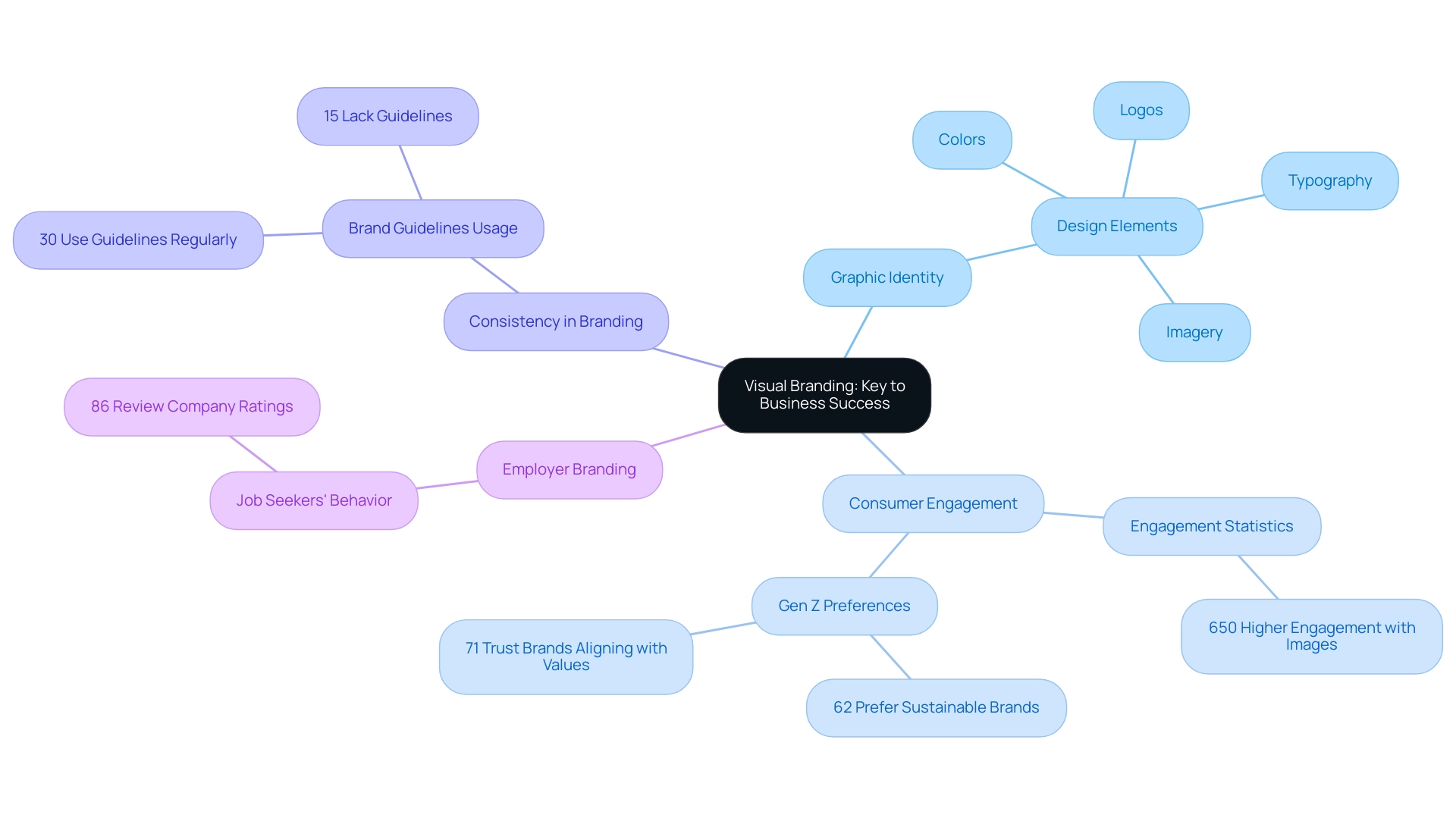
The Core Components of Visual Branding
The fundamental elements of visual branding are critical for crafting a memorable and impactful identity. These elements include:
- Logo: Regarded as the face of the brand, a well-designed logo is essential for recognition and serves as a visual anchor for consumers. Research indicates that logos can significantly influence recall, with studies showing that 75% of consumers can recognize a company by its logo alone. At WonderEight, we have successfully crafted logos for diverse clients, enhancing their visibility across various markets.
- Color Palette: Colors play a pivotal role in evoking emotions and conveying identity. Companies that utilize a consistent color palette can increase recognition by up to 80%. The emotional impact of colors is profound; for instance, blue often conveys trust, while red can evoke excitement. Successful companies leverage these associations to resonate with their target audience. This emotional connection is crucial, particularly given that in 2023, 82% of potential candidates evaluated a company’s reputation before applying for a job. As Ben Franklin aptly stated, “It takes many good deeds to build a reputation, and only one bad one to lose it.” WonderEight has assisted clients in creating color strategies that align with their values and market positioning.
- Typography: The selection of fonts reflects the organization’s voice and character, influencing how messages are perceived. Typography enhances readability and establishes a tone that aligns with the entity’s identity. For example, a luxury label may opt for elegant serif fonts, while a tech company might choose modern sans-serif styles to convey innovation. Our team at WonderEight has curated typographic solutions that resonate with the unique identities of our clients.
- Imagery: Visuals that convey the identity’s story are vital for enhancing messaging and engagement. High-quality images and graphics forge emotional ties with customers, making them more likely to recall and connect with the company. Case studies demonstrate that companies utilizing compelling imagery in their marketing campaigns experience a significant increase in consumer interaction and loyalty. WonderEight has partnered with clients to develop imagery that captures their essence and engages their audience effectively.
- Graphic Elements: Additional design features, such as icons and patterns, support the overall visual identity and help differentiate the brand in a crowded marketplace. Effective use of graphic elements enhances the visual branding and aesthetic appeal of promotional materials. Our innovative method at WonderEight guarantees that these elements are not only visually attractive but also strategically aligned with our clients’ marketing objectives.
Each of these components must work harmoniously to create a strong and memorable presence. As the landscape of marketing evolves, continuous learning and strategic adaptation are crucial for maintaining a competitive edge. The case study on employer image statistics highlights that 69% of job candidates reject offers from companies with poor reputations, underscoring the significance of visual branding in attracting not only customers but also top talent.
WonderEight’s commitment to innovative branding solutions ensures that our clients stand out in their respective industries.
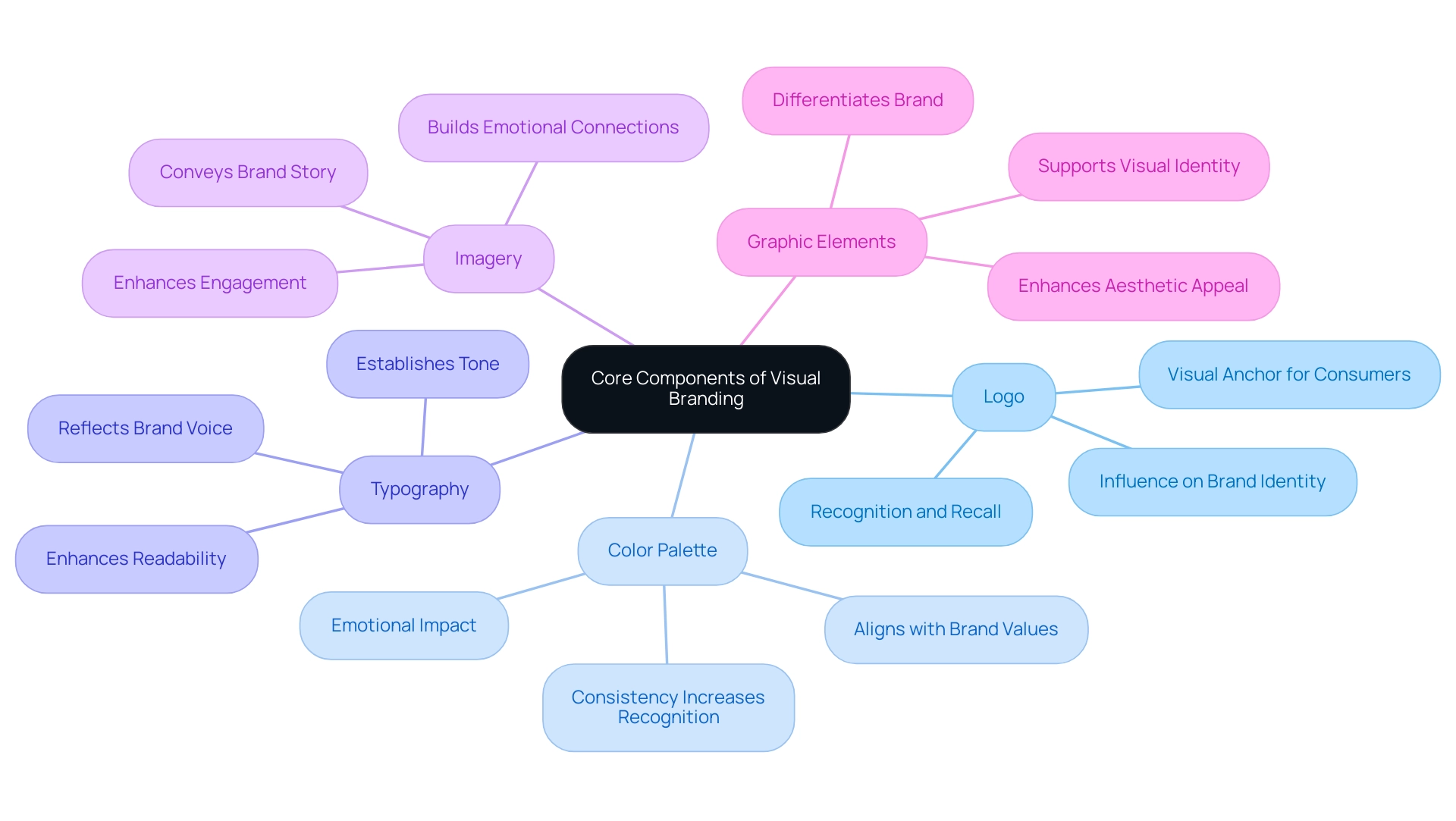
The Power of a Logo: Your Brand’s First Impression
A logo transcends mere graphic representation; it embodies the very essence of a company. At WonderEight, we understand that a logo must be unique, memorable, and a true reflection of the core values of the brand. A thoughtfully designed logo fosters an immediate connection with consumers, significantly influencing their perceptions and nurturing loyalty.
Consider logos such as Nike’s swoosh and Apple’s apple; these are not merely symbols but influential icons that elicit strong associations and feelings connected to their respective identities.
Research indicates that fewer than 10% of B2B firms maintain uniform identity, leading to confusion and weakened recognition. As Joshua Schmitt, Senior Graphic Designer at 4CDesignWorks, articulates, “The most common branding mistake is inconsistency across their branding elements, using different logos, colors, or messaging across various platforms and touchpoints.” This lack of cohesion not only confuses customers but also undermines efforts to establish a strong, memorable identity in the marketplace.
In contrast, a well-designed logo serves as a cornerstone of consistency, reinforcing recognition across various platforms. Furthermore, statistics reveal that 27% of consumers view personalization as essential for fostering loyalty to a brand, underscoring the necessity for logos that connect on a personal level.
Investing in professional logo design is vital for any business aspiring to leave a lasting impression. At WonderEight, we have successfully executed comprehensive marketing campaigns for clients such as Miranda and Quaker Oats, demonstrating how impactful strategies, including effective logo design, can enhance market engagement and foster loyalty. These campaigns not only showcased engaging content but also reinforced the importance of visual branding in connecting with target audiences.
Ultimately, the impact of a logo on consumer perception cannot be overstated; it is a critical element of visual branding that establishes a company’s identity and recognition in the marketplace. WonderEight’s innovative marketing solutions ensure that your logo and overall identity resonate effectively with your audience.
Typography: The Voice of Your Brand
Typography serves as the voice of an organization, playing a pivotal role in shaping its identity and communication. The selection of fonts can evoke a spectrum of emotions and establish the tone for messaging. For instance, serif fonts convey a sense of tradition and reliability, making them suitable for companies aiming to project stability. In contrast, sans-serif fonts typically suggest modernity and simplicity, appealing to contemporary audiences.
Research indicates that typography significantly influences perception of a company, with consumers responding differently to various font styles. A study involving 42 participants revealed that specific typeface design features create a common visual language, impacting emotional responses and associations. Interestingly, the emotional response to Helvetica was not higher compared to other typefaces in advertisements, underscoring the complexity of font perception.
This underscores the importance of aligning typography with corporate identity in visual branding to elicit the desired emotional response.
Consistency in typography across all marketing materials is essential for maintaining a cohesive identity. Brands such as Coca-Cola and Google exemplify this principle, having effectively utilized typography to reinforce their identities and enhance public recognition and loyalty. The psychological impact of typography extends beyond aesthetics; it influences communication tone, contextual relevance, and cultural resonance, enabling companies to connect more deeply with their audiences.
In 2025, understanding client preferences for serif versus sans-serif fonts remains crucial. While serif fonts are often favored for their classic appeal, sans-serif fonts are increasingly popular among younger demographics seeking modernity. This shift highlights the need for companies to adapt their typography strategies to resonate with evolving consumer tastes.
Expert opinions emphasize that by comprehending the psychological associations tied to different font types, companies can enhance their visual branding by better aligning their typography with their overall identity. Andre Kluyts notes, “By understanding the psychological associations of different font types, companies can better align their typography with their identity, set the appropriate tone for a marketing campaign, and elicit the desired emotional response from their visual communications.” This strategic approach not only improves communication but also fosters emotional connections with consumers.
Significant campaigns, such as those executed for Miranda and Quaker Oats, illustrate how effective typography can enhance customer loyalty and market presence, showcasing the tangible impact of thoughtful font choices on success. These campaigns successfully resonated with audiences, reinforcing their identities and driving engagement.
Imagery: Enhancing Your Brand Narrative
Imagery stands as a cornerstone of visual branding, significantly enhancing an organization’s narrative. High-quality images not only evoke emotions but also convey messages effectively, fostering a deeper connection with the audience. It is essential to choose visuals that align with company values and resonate with the target demographic for impactful marketing.
For example, lifestyle companies frequently employ aspirational visuals to forge emotional ties with customers, thereby enhancing the relatability and appeal of their products.
At WonderEight, we understand that the consistent use of imagery across various platforms is vital for strengthening identity. Our customized marketing solutions are designed to craft a cohesive narrative that captivates audiences and promotes engagement. Notably, companies that successfully integrate storytelling with their imagery can achieve remarkable outcomes; studies indicate that emotional storytelling can lead to a 96% increase in conversion rates, as consumers with strong emotional ties to an organization are three times more valuable over their lifetime.
This is substantiated by the case study titled “The Power of Storytelling,” which illustrates how emotional connections fostered through storytelling significantly influence purchasing behavior.
As we look toward 2025, the role of imagery in visual branding is evolving. Data indicates that visuals are processed by the brain 60,000 times faster than text, making them more memorable and impactful. This underscores the importance of high-quality images in enhancing narratives. Furthermore, pairing a compelling story with a product can elevate its perceived value by an astounding 2,706%, emphasizing the power of imagery in building trust and connection with consumers.
As Chefoo asserts, “To leverage influencer marketing effectively, prioritize collaborations that emphasize storytelling.” By harnessing these insights, WonderEight empowers companies to develop more engaging and effective identities that resonate with their audiences.
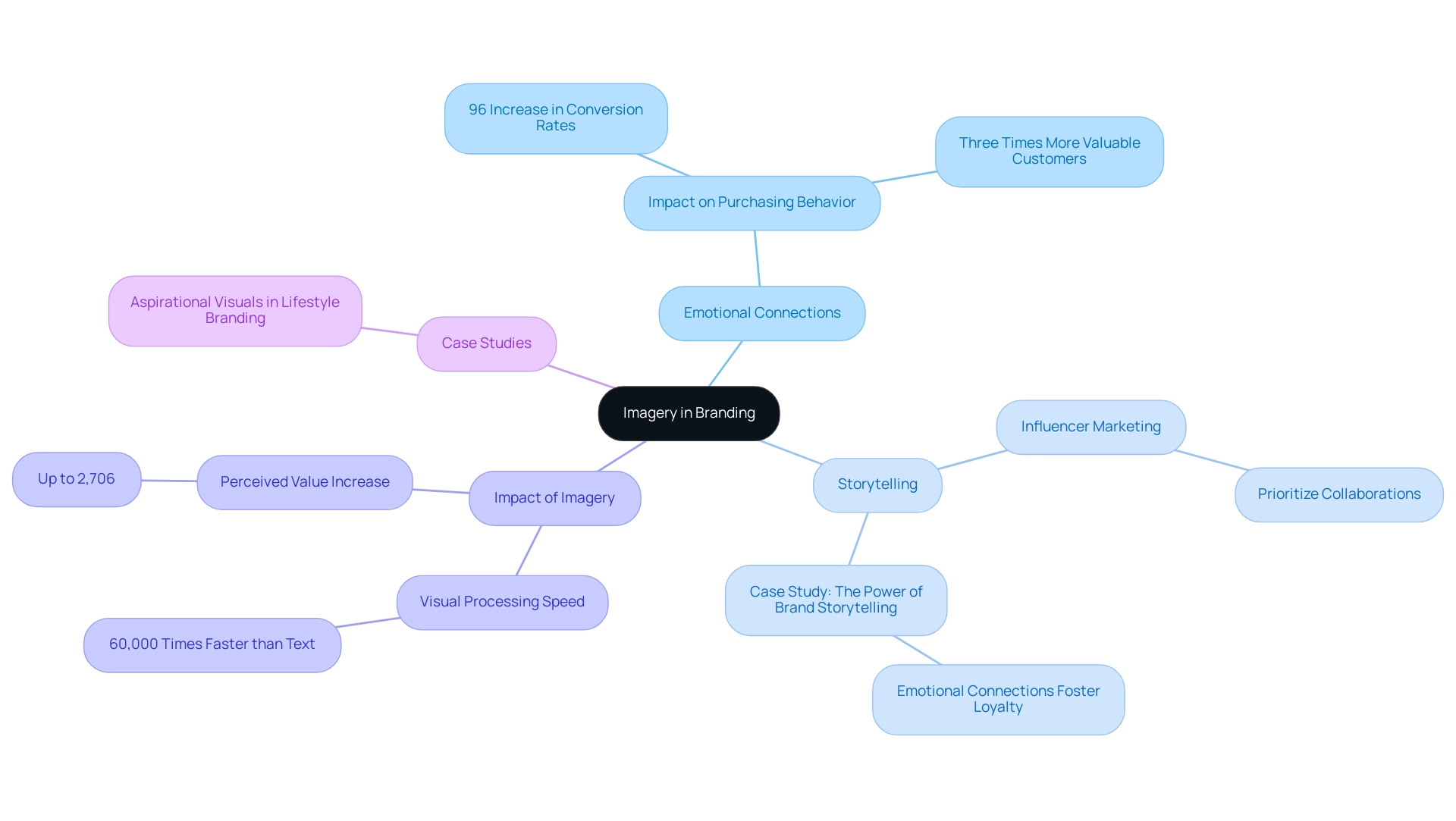
Consistency: The Backbone of Effective Visual Branding
Consistency serves as the backbone of effective visual branding, ensuring that all elements—logos, colors, typography, and imagery—come together to form a cohesive identity. Inconsistent branding leads to customer confusion and significantly undermines identity recognition. Research indicates that 59% of consumers are willing to wait for products to be restocked at their favorite label, underscoring the critical importance of a strong, recognizable identity.
Brands like McDonald’s and Starbucks exemplify the power of consistency; their visual elements are not only instantly recognizable but also evoke a sense of trust and familiarity across global markets. This illustrates how a unified branding approach can create a lasting impact in the minds of consumers.
Establishing clear guidelines is essential for maintaining this consistency across all marketing channels. These guidelines serve as a roadmap for how the company should be represented visually, reinforcing its presence and credibility. Indeed, statistics show that 82% of potential candidates consider a company’s reputation before applying for a job, emphasizing the wider significance of visual branding consistency.
As Ben Franklin wisely noted, “It takes many good deeds to build a reputation, and only one bad one to lose it,” highlighting the critical nature of maintaining a consistent image. The impact of inconsistent branding can be detrimental. For instance, incorporating specific colors into visual branding can enhance recognition by up to 80%, a statistic that underscores WonderEight’s expertise in creating visually appealing identities. Moreover, 45% of consumers highlight the significance of outstanding design in marketing materials, suggesting that aesthetic appeal is a crucial element in consumer engagement—a principle that WonderEight implements in its campaigns, including Packaging & Collateral Design and Social Media Management.
Case studies, such as the comprehensive campaigns created for Mirinda and Quaker Oats by WonderEight, demonstrate how effective visual branding can lead to heightened engagement and customer loyalty. These campaigns concentrated on producing engaging content and impactful experiences, showcasing WonderEight’s ability to resonate with audiences while addressing the significance of consistency. Additionally, WonderEight’s innovative method to Gamification has proven effective in enhancing brand interaction and engagement, further solidifying their position as leaders in the marketing space.
In 2025, the significance of consistency in branding remains paramount. Brands that uphold a consistent graphic identity not only improve public recognition but also cultivate trust and loyalty. Expert insights consistently support that a cohesive aesthetic strategy is essential for companies seeking to succeed in a competitive environment.
By prioritizing consistency, companies can ensure they remain top-of-mind for customers, ultimately driving business success.
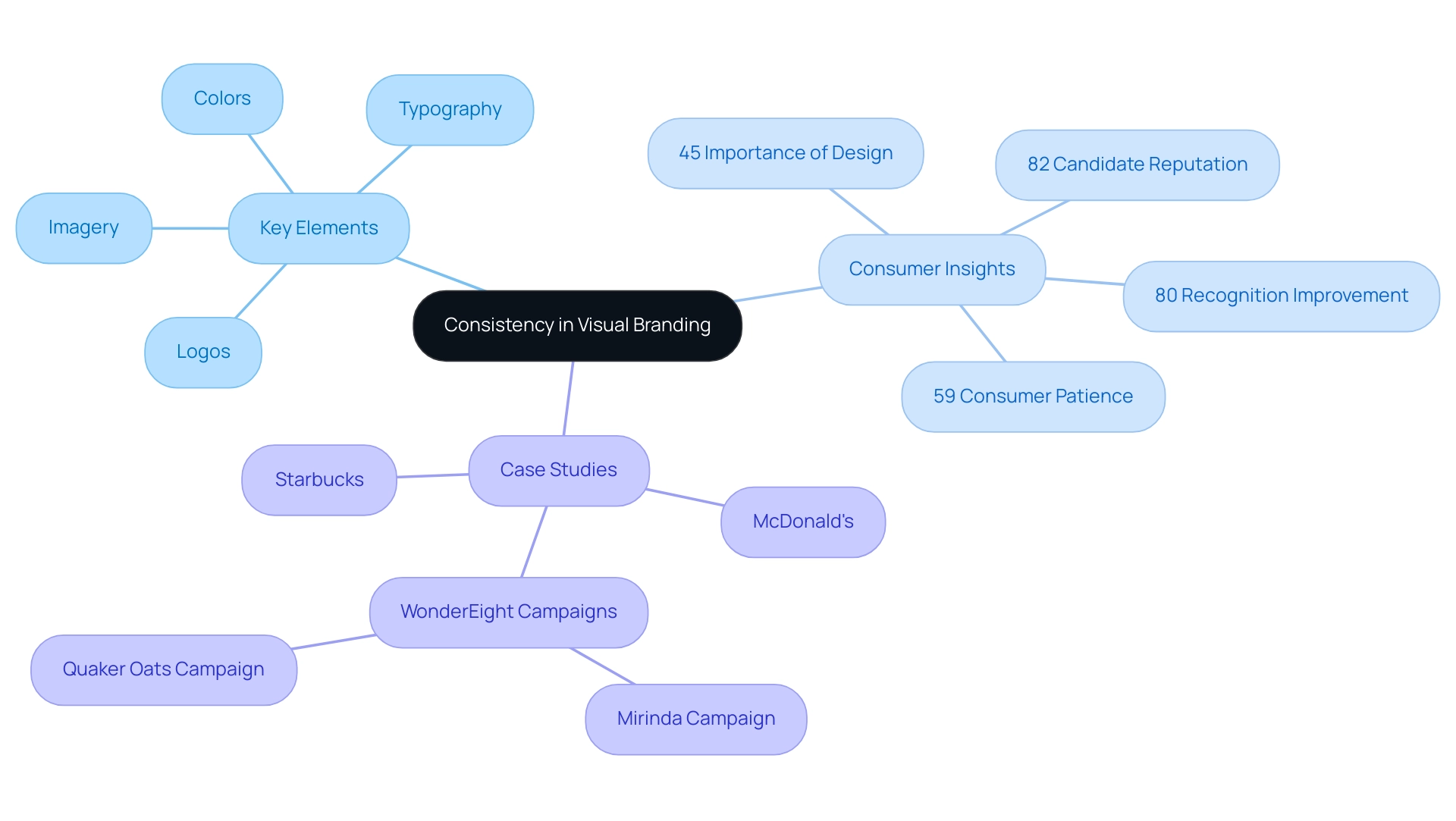
The Future of Visual Branding: Trends to Watch
As we look ahead, several key trends are decisively shaping the future of visual identity in 2025:
- Bold Colors: The rise of vibrant colors is notable, as companies increasingly leverage bold palettes to capture attention in a market that is becoming ever more saturated. Data supports this trend, indicating that organizations utilizing vivid colors can significantly enhance public perception and awareness.
- Minimalism: Simplified designs are gaining substantial traction, emphasizing essential elements to convey messages with clarity and impact. This approach not only streamlines communication for businesses but also fortifies visual branding by resonating with individuals who seek authenticity and clarity in marketing.
- Sustainability: Eco-friendly marketing is emerging as a priority for many companies, marked by a shift towards natural colors and sustainable materials. This trend reflects a growing demand from consumers for brands that demonstrate environmental responsibility, aligning with the values of today’s conscientious shoppers.
- Dynamic Logos: The advent of adaptable logos empowers companies to maintain flexibility across various contexts, enhancing their relevance in a fast-paced digital landscape. This trend enables organizations to connect with diverse audiences more effectively, ensuring that their visual identity remains both consistent and adaptable.
- Inclusive Imagery: There is a distinct emphasis on diversity and representation in graphic content. Brands are increasingly prioritizing inclusive imagery to reflect the diverse demographics of their audience, fostering a sense of connection and trust.
By embracing these trends, businesses can ensure their visual branding remains fresh and relevant, ultimately driving engagement and loyalty. Significantly, a recent study revealed that only approximately one in three individuals trust most brands they interact with, underscoring the necessity of crafting a dependable identity. Furthermore, in 2023, 82% of prospective candidates considered a company’s reputation before applying for a position, highlighting the critical role that impactful imagery plays in attracting talent.
As Josh Howarth aptly noted, ‘It takes many good deeds to build a reputation, and only one bad one to lose it.’ This statement underscores the pivotal role that effective visual branding plays in establishing and maintaining consumer trust. Additionally, with only 18% of marketers currently utilizing AI to create videos, there exists a significant opportunity for brands to innovate in their visual storytelling, further enhancing their connection with audiences.
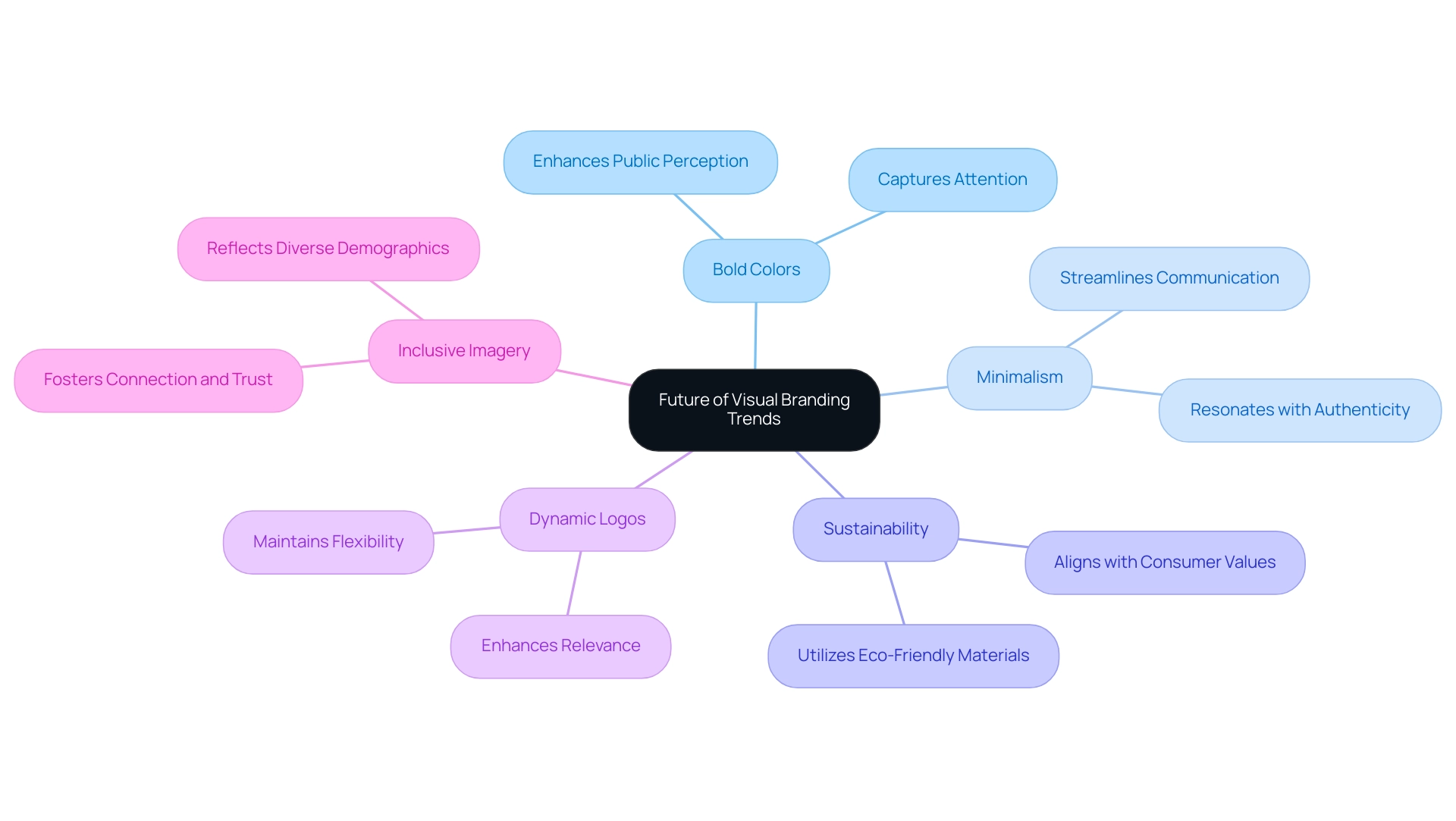
Conclusion
In conclusion, effective visual branding stands as an indispensable pillar for businesses aiming for success in today’s competitive landscape. The core components—logos, color palettes, typography, imagery, and graphic elements—collaborate to forge a cohesive and impactful brand identity. A well-crafted logo serves as the cornerstone for recognition, while a thoughtfully chosen color palette evokes emotions and conveys brand values. Typography embodies the voice of the brand, shaping perceptions and emotional responses, and high-quality imagery enriches storytelling, fostering deeper connections with consumers.
Furthermore, the importance of consistency in visual branding cannot be overstated. Brands that present a unified visual identity cultivate trust and recognition among their audiences, whereas inconsistency can lead to confusion and erode brand loyalty. Successful case studies illustrate that meticulous attention to detail in visual branding not only attracts customers but also appeals to potential employees, highlighting the broader implications of a robust visual identity.
Looking ahead, brands must remain vigilant in adapting to emerging trends such as bold colors, minimalism, sustainability, dynamic logos, and inclusive imagery. By embracing these trends, businesses can refine their visual branding strategies to resonate with consumers and foster enduring relationships. Ultimately, a steadfast commitment to effective visual branding will not only elevate a brand’s presence but also drive engagement and loyalty, securing long-term success in an ever-evolving marketplace.
Frequently Asked Questions
What is graphic identity and why is it important?
Graphic identity encompasses design elements such as logos, colors, typography, and imagery that symbolize a brand. It is crucial for shaping public perception and influences consumers’ emotional connections with a brand, which is essential for business success in a competitive market.
How does a strong graphic identity benefit businesses?
A robust graphic identity promotes customer recognition, cultivates trust and loyalty, and attracts new clientele. It can significantly enhance engagement, as posts with images generate 650% more engagement than text-only posts.
What challenges do businesses face in maintaining graphic identity?
Many businesses struggle with consistency; only 30% adhere to their branding guidelines regularly, and 15% have no guidelines at all. This inconsistency can undermine recognition and trust among consumers.
How do consumer values influence visual branding?
Research shows that consumers, particularly Gen Z, prioritize sustainability, inclusion, and diversity in their purchasing decisions. For instance, 62% of Gen Z shoppers prefer companies that focus on sustainability, highlighting the need for brands to align their visual identity with customer values.
What role does graphic identity play in employer branding?
A cohesive aesthetic identity can attract top talent, as 86% of job seekers review company ratings before applying. A strong visual identity reflects a company’s values and culture, influencing candidates’ perceptions.
What are the fundamental elements of visual branding?
The key elements include: Logo: Serves as the brand’s face and is crucial for recognition. Color Palette: Evokes emotions and enhances brand recognition by up to 80%. Typography: Reflects the brand’s voice and influences message perception. Imagery: High-quality visuals enhance engagement and emotional connections. Graphic Elements: Icons and patterns support the overall visual identity and differentiate the brand.
Why is consistency in visual branding important?
Consistency helps reinforce brand recognition and trust, making it vital for businesses to maintain a cohesive visual identity across all platforms and materials.
How does visual branding impact consumer behavior?
Effective visual branding can enhance customer loyalty and influence purchasing decisions, as compelling imagery in marketing campaigns leads to increased consumer interaction.
What is the future outlook for visual branding?
The impact of visual branding on consumer perception is expected to intensify, making it essential for companies to invest in cultivating a cohesive and appealing identity that effectively communicates their values.



